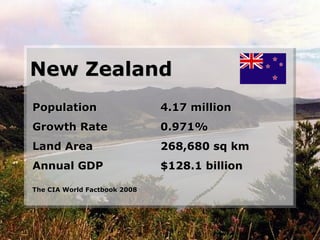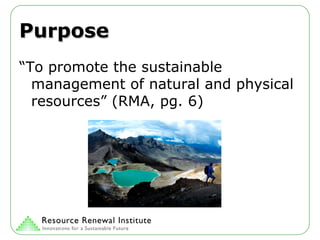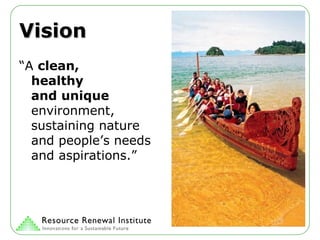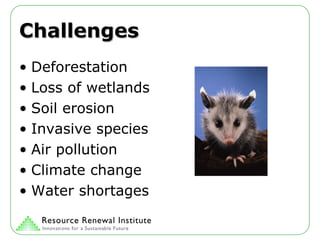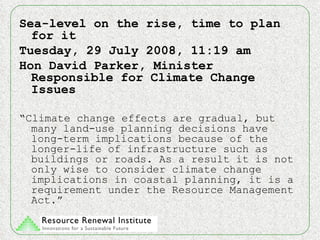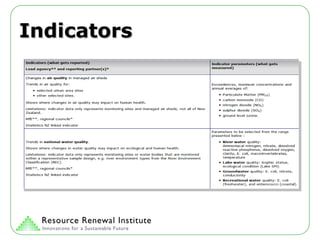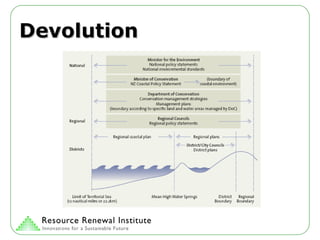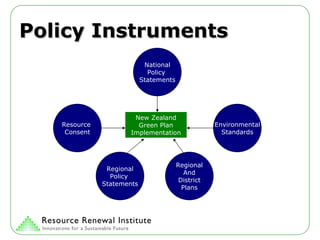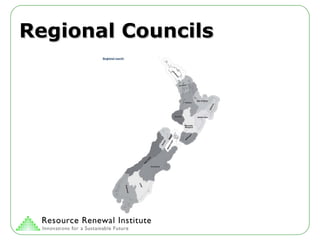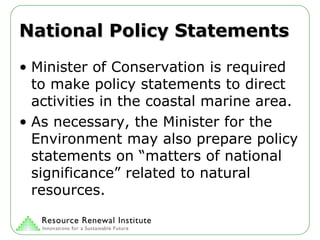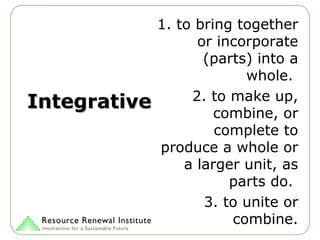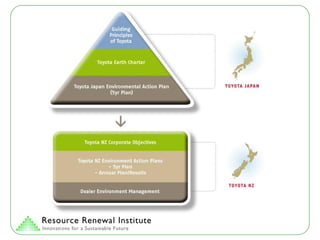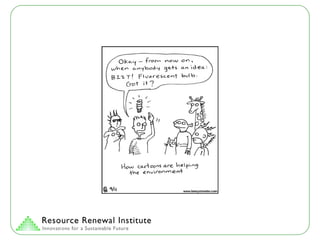New Zealand Green Plan
- 1. New Zealand Population 4.17 million Growth Rate 0.971% Land Area 268,680 sq km Annual GDP $128.1 billion The CIA World Factbook 2008
- 3. Resource Management Act Adopted in 1991 following four years of research, discussion, and drafting Largest law reform process in national history 20 major statutes and 50 other environmental laws were replaced
- 4. Purpose “To promote the sustainable management of natural and physical resources” (RMA, pg. 6)
- 5. Vision “ A clean, healthy and unique environment, sustaining nature and people’s needs and aspirations.”
- 6. Principles Sustainable development Environmentally-harmful activities should be avoided or mitigated Social and economic benefits will not outweigh environmental consequences in a cost-benefit analysis Environmental stewardship
- 7. Additional Principles Polluter pays Finite characteristics of resources Need for trout and salmon protection Humans impact climate change Support for renewable energy Support for improved energy efficiency Preservation of cultural and historical heritage
- 8. Comprehensive 1. of large scope; covering or involving much; inclusive 2. comprehending mentally; having an extensive mental range or grasp.
- 9. Challenges Deforestation Loss of wetlands Soil erosion Invasive species Air pollution Climate change Water shortages
- 10. Sea-level on the rise, time to plan for it Tuesday, 29 July 2008, 11:19 am Hon David Parker, Minister Responsible for Climate Change Issues “ Climate change effects are gradual, but many land-use planning decisions have long-term implications because of the longer-life of infrastructure such as buildings or roads. As a result it is not only wise to consider climate change implications in coastal planning, it is a requirement under the Resource Management Act.”
- 11. Indicators Monitored by the Ministry for the Environment Air quality Greenhouse gas emissions and stratospheric ozone Freshwater quality and allocation Land cover and land use Indigenous biodiversity Energy demand
- 12. Indicators
- 13. Additional Indicators Economic Indicators Social Health Indicators
- 14. Systemic of or pertaining to a system. Physiology, Pathology. (a) pertaining to or affecting the body as a whole. (b) pertaining to or affecting a particular body system.
- 15. Devolution Implementation has been largely devolved to regional councils and to district and city councils.
- 16. Devolution
- 17. Policy Instruments New Zealand Green Plan Implementation Resource Consent Environmental Standards National Policy Statements Regional And District Plans Regional Policy Statements
- 19. Devolution
- 20. Regional Councils There are 12 regional councils. Responsibilities include: Managing the use of surface water and groundwater Discharge of contaminants onto land or into the air or water Effects of activities in coastal marine area Invasive species in water bodies Biodiversity Soil conservation Water quality/quantity Infrastructure as it relates to land use planning
- 22. Regional Policy Statements Statements must establish “a directional framework” for handling natural resource issues specific to that region. Statements must be reviewed within 10 years of implementation.
- 23. District and City Councils There are 73 district and city councils. District councils are responsible for: Managing the effects of land-use Handling noise pollution Mitigating the effects of various activities on lakes and rivers
- 24. District and City Councils
- 25. Regional and District Plans Plans are prepared to directly address issue-specific environmental problems that arise. Plans include detailed objectives, policies, and rules to mitigate the issue. Combined plans may be created to address cross-boundary issues. Plans are revised every 10 years.
- 26. Regional and District Plans Regional and district councils are encouraged to consider alternatives to regulation whenever possible. Ex. Grants for home improvement
- 27. Resource Consent This process is used to grant permission for any activity that has an impact on the environment or any activity prohibited under existing law. Resource consents are granted by consent authorities including regional, district and city councils, and the Department of Conservation.
- 28. Resource Consent
- 29. Resource Consent 55,000 resource consents were processed between 2003 and 2004. Applications for resource consent require an assessment of environmental impact and in some cases a written approval from affected parties.
- 30. Resource Consent
- 31. Resource Consent
- 32. Resource Consent After resource consent is granted, regional and district councils have the power to issue abatement notices.
- 33. Resource Consent
- 35. National Policy Statements Minister of Conservation is required to make policy statements to direct activities in the coastal marine area. As necessary, the Minister for the Environment may also prepare policy statements on “matters of national significance” related to natural resources.
- 36. National Environmental Standards The Minister of Conservation prepares standards that serve as regulations to guide resource consent. Standards: Air quality Drinking water quality
- 37. Source: WEF (2005), Global Competitiveness Report 2004/2005. Overall Infrastructure Quality
- 38. Accountable 1. subject to the obligation to report, explain, or justify something; responsible; answerable. 2. capable of being explained; explicable; explainable.
- 39. Environment Court The Environment Court has the following powers: Direct councils to change plans or policy statements Confirm, amend, or cancel resource consents Change abatement notices Make or decline declarations or enforcement orders Award payments or issue fines
- 40. Environment Court Violation of any part of the Resource Management Act if an offense punishable with imprisonment for up to two years or a fine not exceeding $200,000. Decisions made in the Environment Court may be appealed to the High Court.
- 41. Integrative 1. to bring together or incorporate (parts) into a whole. 2. to make up, combine, or complete to produce a whole or a larger unit, as parts do. 3. to unite or combine.
- 42. Community Involvement Based on the following principles: That decisions on environmental matters are most appropriately made by the communities directly affected by those decisions; That community participation is vital to effective resource management.
- 43. Community Involvement Citizens, interest groups, and business leaders can participate in the regional and district plan preparation process by making a written submission.
- 45. Govt 3 Program Led by the Ministry for the Environment's Sustainable Industry Group, government agencies work together to share ideas and information in hopes of strengthening central government while increasing sustainability.
- 46. Govt 3 Program
- 50. Review In 2004, the Minister of the Environment began a review of the Resource Management Act. For 18 months, the Ministry consulted with local government, industry, environmental organizations, and the community to ensure that all opinions were represented in the review.
- 51. Review
- 52. Speech to Local Government New Zealand Conference Monday, 28 July 2008, 4:16 pm John Key MP, National Party Leader “ We will simplify and streamline processes around the Resource Management Act . We are also aware of the significant issues you face administering the Building Act, and we will work with you to resolve those. I can assure you that National will be talking in more detail about these issues closer to the election. “
